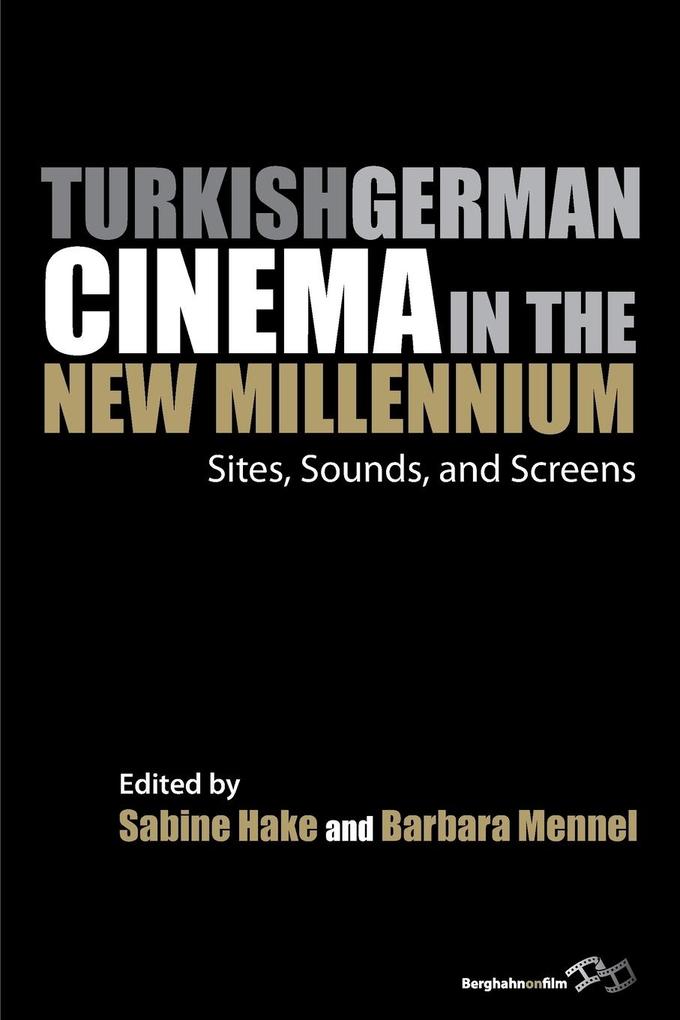
Zustellung: Mo, 16.06. - Do, 19.06.
Versand in 6 Tagen
VersandkostenfreiBestellen & in Filiale abholen:
In the last five years of the twentieth century, films by the second and third generation of the so-called German guest workers exploded onto the German film landscape. Self-confident, articulate, and dynamic, these films situate themselves in the global exchange of cinematic images, citing and rewriting American gangster narratives, Kung Fu action films, and paralleling other emergent European minority cinemas. This, the first book-length study on the topic, will function as an introduction to this emergent and growing cinema and offer a survey of important films and directors of the last two decades. In addition, it intervenes in the theoretical debates about Turkish German culture by engaging with different methodological approaches that originate in film studies.
Inhaltsverzeichnis
Introduction
PART I: CONFIGURATIONS OF STEREOTYPES AND IDENTITIES: NEW METHODOLOGIES
Chapter 1. My Big Fat Turkish Wedding: From Culture Clash to Romcom
Daniela Berghahn
Chapter 2. The Oblivion of Influence: Transmigration, Tropology, and Myth-Makingin Feo Aladag's When We Leave
David Gramling
Chapter 3. The Minor Cinema of Thomas Arslan: A Prolegomenon
Marco Abel
PART II: MULTIPLE SCREENS AND PLATFORMS: FROM DCOUMENTARY AND TELEVISION TO INSTALLATION ART
Chapter 4. Roots and Routes of the Diasporic Documentarian: A Psychogeography of Fatih Akin's We Forgot to Go Back
Angelica Fenner
Chapter 5. Gendered Kicks: Buket Alakus's and Aysun Bademsoy's Soccer Films
Ingeborg Majer-O'Sickey
Chapter 6. Location and Mobility in Kutlug Ataman's Site-specific Video Installation Kü ba
Nilgun Bayraktar
Chapter 7. Turkish for Beginners: Teaching Cosmopolitanism to Germans
Brent Peterson
Chapter 8. "Only the Wounded Honor Fights": Zü li Aladag's Rageand the Drama of the Turkish German Perpetrator
Brad Prager
PART III: INSTITUTIONAL CONTEXTS: STARS, THEATRES, AND RECEPTON
Chapter 9. The German Turkish Spectator and Turkish Language Film Programming: Karli-Kino, Maxximum Distribution, and the Interzone Cinema
Randall Halle
Chapter 10. Mehmet Kurtulus and Birol Ü nel: Sexualized Masculinities, Normalized Ethnicities
Berna Gueneli
Chapter 11. The Perception and Marketing of Fatih Akin in the German Press
Karolin Machtans
Chapter 12. Hyphenated Identities: The Reception of Turkish German Cinema in the Turkish Daily Press
Ayç a Tunç Cox
PART IV: THE CINEMA OF FATIH AKIN: AUTHORSHIP, IDENTITY, AND BEYOND
Chapter 13. Cosmopolitan Filmmaking: Fatih Akin's In July and Head-On
Mine Eren
Chapter 14. Remixing Hamburg: Transnationalism in Fatih Akin's Soul Kitchen
Roger Hillman and Vivien Silvey
Chapter 15. World Cinema Goes Digital: Looking at Europe from the Other Shore
Deniz Gö ktü rk
Notes on Contributors
Works Cited
Index of Names
Index of Films
PART I: CONFIGURATIONS OF STEREOTYPES AND IDENTITIES: NEW METHODOLOGIES
Chapter 1. My Big Fat Turkish Wedding: From Culture Clash to Romcom
Daniela Berghahn
Chapter 2. The Oblivion of Influence: Transmigration, Tropology, and Myth-Makingin Feo Aladag's When We Leave
David Gramling
Chapter 3. The Minor Cinema of Thomas Arslan: A Prolegomenon
Marco Abel
PART II: MULTIPLE SCREENS AND PLATFORMS: FROM DCOUMENTARY AND TELEVISION TO INSTALLATION ART
Chapter 4. Roots and Routes of the Diasporic Documentarian: A Psychogeography of Fatih Akin's We Forgot to Go Back
Angelica Fenner
Chapter 5. Gendered Kicks: Buket Alakus's and Aysun Bademsoy's Soccer Films
Ingeborg Majer-O'Sickey
Chapter 6. Location and Mobility in Kutlug Ataman's Site-specific Video Installation Kü ba
Nilgun Bayraktar
Chapter 7. Turkish for Beginners: Teaching Cosmopolitanism to Germans
Brent Peterson
Chapter 8. "Only the Wounded Honor Fights": Zü li Aladag's Rageand the Drama of the Turkish German Perpetrator
Brad Prager
PART III: INSTITUTIONAL CONTEXTS: STARS, THEATRES, AND RECEPTON
Chapter 9. The German Turkish Spectator and Turkish Language Film Programming: Karli-Kino, Maxximum Distribution, and the Interzone Cinema
Randall Halle
Chapter 10. Mehmet Kurtulus and Birol Ü nel: Sexualized Masculinities, Normalized Ethnicities
Berna Gueneli
Chapter 11. The Perception and Marketing of Fatih Akin in the German Press
Karolin Machtans
Chapter 12. Hyphenated Identities: The Reception of Turkish German Cinema in the Turkish Daily Press
Ayç a Tunç Cox
PART IV: THE CINEMA OF FATIH AKIN: AUTHORSHIP, IDENTITY, AND BEYOND
Chapter 13. Cosmopolitan Filmmaking: Fatih Akin's In July and Head-On
Mine Eren
Chapter 14. Remixing Hamburg: Transnationalism in Fatih Akin's Soul Kitchen
Roger Hillman and Vivien Silvey
Chapter 15. World Cinema Goes Digital: Looking at Europe from the Other Shore
Deniz Gö ktü rk
Notes on Contributors
Works Cited
Index of Names
Index of Films
Produktdetails
Erscheinungsdatum
01. September 2014
Sprache
englisch
Seitenanzahl
260
Herausgegeben von
Sabine Hake, Barbara Mennel
Verlag/Hersteller
Produktart
kartoniert
Gewicht
382 g
Größe (L/B/H)
229/152/14 mm
ISBN
9781782386650
Entdecken Sie mehr
Bewertungen
0 Bewertungen
Es wurden noch keine Bewertungen abgegeben. Schreiben Sie die erste Bewertung zu "Turkish German Cinema in the New Millennium" und helfen Sie damit anderen bei der Kaufentscheidung.









